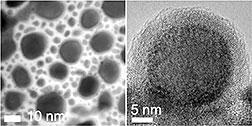- Number 392 |
- July 8, 2013
Exposure to air transforms gold alloys into catalytic nanostructures

Left: Multiple gold-indium alloy nanoparticles
at room temperature. Right: One
nanoparticle's crystalline gold-indium core
surrounded by the amorphous catalytic
oxide shell.
Gold bars may signify great wealth, but the precious metal packs a much more practical punch when shrunk down to just billionths of a meter. Unfortunately, unlocking gold's potential often requires complex synthesis techniques that produce delicate structures with extreme sensitivity to heat.
Now, scientists at Brookhaven Lab have discovered a way to make uniquely structured gold-indium nanoparticles that combine high stability, great catalytic potential, and a simple synthesis process. The new nanostructures might enhance many commercial and industrial processes, including acting as an efficient material for catalytic converters in cars.
"We discovered a room-temperature process that transforms a simple alloy into a nanostructure with remarkable properties," said Brookhaven physicist Eli Sutter, lead author on the study. The trick was giving gold-indium nanoparticles a little room to breathe. Once nanoparticles of the metal alloy were exposed to oxygen, highly reactive shells of gold-indium oxide formed across their surfaces.
"By exposing the gold-indium alloy nanoparticles to air, ambient oxygen was able to drive an oxidation reaction that converted them into an active core-shell structure," Sutter said.
Trapping gold in the amorphous oxide shell retains its catalytic properties and prevents the gold from sintering—fusing together into much larger pieces that lose the reactivity that’s crucial to an effective catalyst. The new nanostructures proved capable of converting oxygen and carbon monoxide into carbon dioxide, demonstrating their catalytic activity.
The research was conducted at Brookhaven Lab's Center for Functional Nanomaterials(CFN), whose unique facilities for nanoscale synthesis and characterization proved central to the discovery of this new process.[Justin Eure, 631.344.2347,
jeure@bnl.gov]
